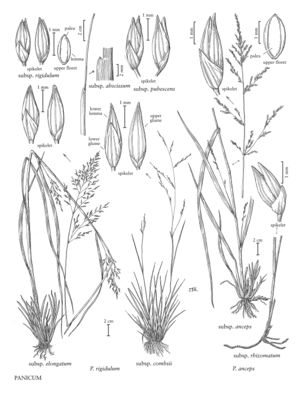Difference between revisions of "Panicum rigidulum subsp. abscissum"
FNA>Volume Importer |
FNA>Volume Importer |
||
| Line 15: | Line 15: | ||
-->{{Treatment/Body | -->{{Treatment/Body | ||
| − | |discussion=<p | + | |discussion=<p>Panicum rigidulum subsp. abscissum is endemic to central Florida. It usually grows in marshy, sandy ground, but is occasionally found in dry, sandy sites (e.g., the type specimen, collected near Lake Sebring).</p><!-- |
| − | --><p | + | --><p>Panicum rigidulum subsp. abscissum is very similar vegetatively and reproductively to subsp. pubescens and subsp. combsii. In addition, its spikelets also suggest those of P. virgatum.</p> |
|tables= | |tables= | ||
|references= | |references= | ||
| Line 32: | Line 32: | ||
|basionyms= | |basionyms= | ||
|family=Poaceae | |family=Poaceae | ||
| + | |illustrator=Linda A. Vorobik and Cindy Roché | ||
|reference=None | |reference=None | ||
|publication title= | |publication title= | ||
|publication year= | |publication year= | ||
|special status= | |special status= | ||
| − | |source xml=https:// | + | |source xml=https://bibilujan@bitbucket.org/aafc-mbb/fna-data-curation.git/src/314eb390f968962f596ae85f506b4b3db8683b1b/coarse_grained_fna_xml/V25/V25_1272.xml |
|subfamily=Poaceae subfam. Panicoideae | |subfamily=Poaceae subfam. Panicoideae | ||
|tribe=Poaceae tribe Paniceae | |tribe=Poaceae tribe Paniceae | ||
Revision as of 16:14, 30 October 2019
Plants yellowish-green. Culms compressed, densely cespitose. Sheaths strongly keeled, 3-6 mm wide from the keel to the margins, truncate or broadly auriculate, occasionally ciliate distally; ligules minute, membranous; blades 0.7-1.5 mm wide from the blunt keel to the margins, to 2.5 mm wide overall, thick, curved or flexuous, rigid, glabrous or scabridulous on both surfaces and along the margins, bases much narrower than the subtending sheaths, margins often sparsely ciliate, with long, slender hairs near the base. Panicles slender, purplish, long-exserted; branches few, appressed or ascending, with relatively few spikelets. Spikelets 2.4-2.8(3) mm, purplish, glabrous, obliquely set on the pedicels, mostly abortive. Lower glumes 1.6-2 mm, often divergent; upper glumes and lower lemmas subequal, often spreading apart.
Discussion
Panicum rigidulum subsp. abscissum is endemic to central Florida. It usually grows in marshy, sandy ground, but is occasionally found in dry, sandy sites (e.g., the type specimen, collected near Lake Sebring).
Panicum rigidulum subsp. abscissum is very similar vegetatively and reproductively to subsp. pubescens and subsp. combsii. In addition, its spikelets also suggest those of P. virgatum.
Selected References
None.
